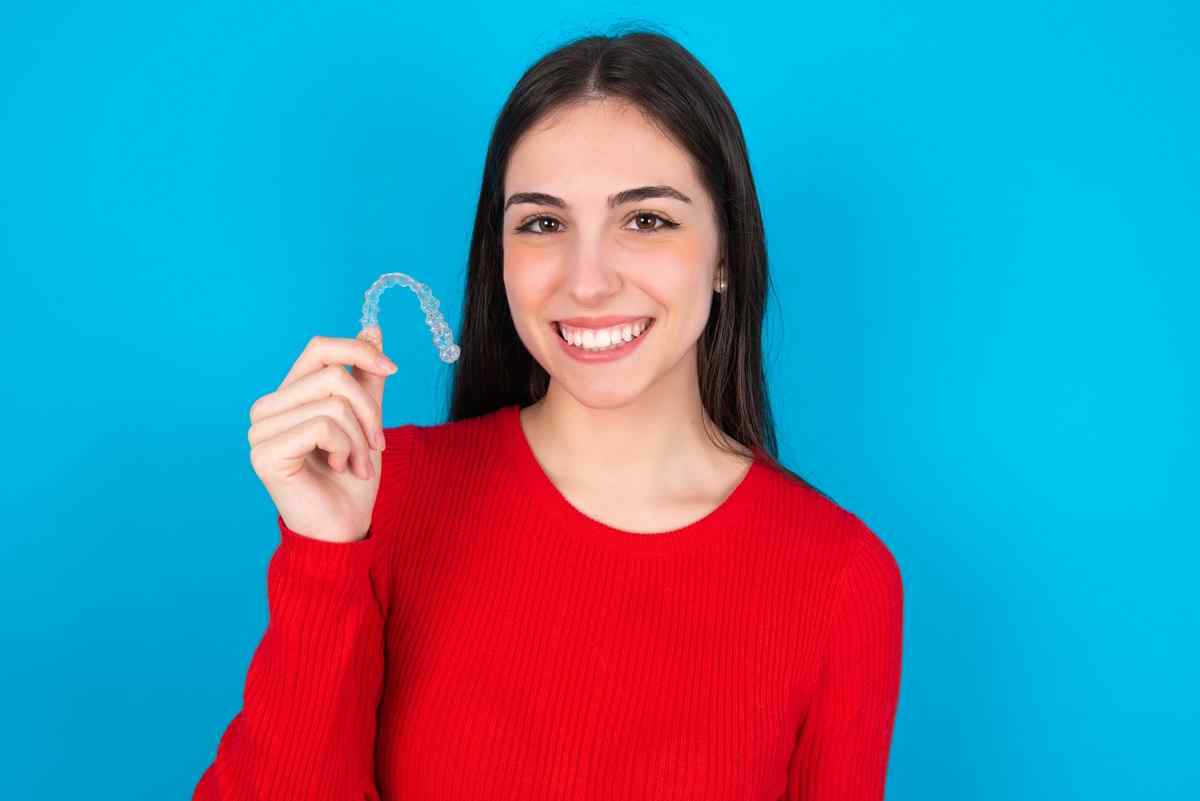What Does Invisalign Look Like? Know What Issues Can It Fix

Millions of people opt for Invisalign to enhance their smile since its name suggests what they are looking for – invisibility. Although no product is completely invisible, the clear aligners used by Invisalign make it far less noticeable than metal or even ceramic braces.
The Invisalign aligners, known as trays, are crafted from clear plastic that fits tightly over your top and bottom teeth. When compared to metal braces, what makes Invisalign so attractive is its inconspicuousness – even though some people may still be able to notice them, depending on the situation. Here’s everything you need to know about this widely sought-after treatment.
What does Invisalign actually fix?
Invisalign is a game-changer if compared to traditional braces when it comes to correcting various bite issues, such as overbite and overjet, underbite, crossbite, and crowding. Invisalign can also be utilised for closing small spaces in the instance of diastema or aligning teeth for dental implants/bridges. Now that we have established what issues Invisalign can fix, let’s dive further into each one!
Invisalign for overbite
A slight overbite is a normal dental condition where the top teeth marginally overlap the lower ones. However, an unhealthy overbite occurs when there is too much of this overlap and can lead to myriad issues such as wear on your teeth, jaw pain or even breakage for those with particularly prominent front top teeth. If left untreated, this malocclusion could have serious implications down the line -so make sure to see your dentist if you find yourself in need of help.
Is Invisalign a viable option to treat an overbite? Absolutely. Your dentist may use Invisalign in conjunction with special attachments, such as elastic bands or precision wings at the back of your teeth and jaws, depending on the severity of your overbite. These mandibular aides will help shift both dentition and jaw into their ideal positions for maximum well-being and oral function.
Invisalign for overjet
 When we hear the term “buck teeth,” it’s easy to understand what it means. Overjet, otherwise known as “buck teeth”, occurs when your upper front teeth protrude excessively. In extreme cases, some people can’t close their mouths without getting in trouble with their top front teeth. This dental condition is often hereditary but may also be caused by prolonged baby habits such as thumbsucking and bottle use. Having overjet or bucked teeth makes these topmost incisors more prone to damage over time – something nobody wants.
When we hear the term “buck teeth,” it’s easy to understand what it means. Overjet, otherwise known as “buck teeth”, occurs when your upper front teeth protrude excessively. In extreme cases, some people can’t close their mouths without getting in trouble with their top front teeth. This dental condition is often hereditary but may also be caused by prolonged baby habits such as thumbsucking and bottle use. Having overjet or bucked teeth makes these topmost incisors more prone to damage over time – something nobody wants.
Invisalign for overjet oftentimes realigns the front-most teeth with the rest of your upper row and concurrently corrects an overbite that may be causing these teeth to protrude excessively.
Invisalign for underbite
An overbite is the opposite of an underbite: when your mouth closes, the lower teeth are positioned in front. An underbite often occurs due to a faster growth rate in the lower jaw which can cause it to protrude more than usual. This misalignment of teeth could result in difficulty speaking or chewing correctly and may also lead to uneven wear on them.
In the past, many underbite cases required surgery and dental treatment to correct; however, due to advanced techniques and treatments now available, more severe forms of this condition can be resolved without surgical intervention via Invisalign alone.
Invisalign for crossbite
If you experience a crossbite, it means some of your top teeth will be positioned inside the bottom ones when you close your mouth. You may have either a back or front crossbite, depending on which area is affected. When left untreated, this condition can result in worn teeth and chips while also causing gum recession and notches above the gum line that might cause discomfort.
Crossbites are mainly caused by the premature loss of baby teeth, trauma to the mouth, hereditary factors or bad oral hygiene practices. Because people often try to adjust their bite by moving their jaw in one direction, which can lead to facial distortions and hinder jaw development, it is essential that you address a crossbite as soon as possible. Invisalign treatments have been known to rectify most cases, with additional attachments being added if necessary for further encouragement of tooth movements.
Invisalign for crowded teeth
When your jaw is too small to fit all of your teeth, crowding can become a troublesome issue. Overlapping, bunching up and shifting out of place are the most frequent signs that this is happening; however, it may have major consequences for oral health! It’s more complicated to keep crowded teeth clean, which leads to an increased risk of tooth decay, cavities and even gum diseases!
If you are struggling with crowding your teeth, Invisalign could be the perfect solution. Not only is it an effective choice for creating more space and shifting your pearly whites into their ideal positions, but in cases that require even further adjustments, our dentist can add special tooth-coloured attachments to help move them exactly where they need to go!
The duration of Invisalign treatment for crowded teeth varies from patient to patient, depending on the particulars of your case.
Do I need to use Invisalign clear aligners 24/7?
To achieve desirable results through the Invisalign journey, patients must keep their Invisalign trays on for 20-22 hours a day. This inevitably leads to social encounters with the aligners in place, making it essential that proper use and care are taken into account.
 When it comes to being aware of Invisalign, the duration and type of encounter play a crucial role. For example, if you’re having a short exchange with someone on the street or at a store, then they are less likely to notice.
When it comes to being aware of Invisalign, the duration and type of encounter play a crucial role. For example, if you’re having a short exchange with someone on the street or at a store, then they are less likely to notice.
On the other hand, in more intimate interactions like job interviews or dates—or even while delivering an address before an audience—the chances that your trays will be noticed increase substantially. The longer and closer you talk with somebody else during these meetings, the better their chance is of recognising your Invisalign.
What people might notice about Invisalign?
Despite its subtlety, there are a few indications of Invisalign that may be spotted. The plastic trays cover the top and bottom teeth completely; although they’re thin and clear-coloured, they still manage to add some breadth to the mouth while talking – something that can easily be noticed by people conversing with you.
Invisalign’s plastic is subtly textured to imitate the texture of your actual teeth, making them look less glossy than other aligners. Although in direct sunlight or bright light, they may appear a bit shinier than real teeth, Invisalign still stands out as one of the least noticeable options on the market due to its subtlety and resemblance to natural enamel.
Moreover, Invisalign’s clear plastic trays are shaped to mimic the natural gum line more successfully than other products. Unlike straight edges, which merely cut above the gum line, these trays have a scalloped edge that not only follows your teeth contour but also appears far less conspicuous. Many customers suggest Invisalign as an exquisite choice when it comes to invisibility and comfort.
Invisalign removal and replacement
An exciting feature of Invisalign is that you may take them off anytime, and your trays must be removed whenever consuming food or beverages. It’s likely people will pay more attention to the fact when you’re taking out -or putting on– your aligners than if they were simply wearing them all day long.
Remember, eating anything other than water while sporting these trays can cause staining and damage! To stay on top of hygiene and avoid any uncomfortable situations, it’s a good idea to bring a case along with you so that you can safely store away the removable aligners — not only does this keep everything hygienic, but it also eliminates seeing Invisalign placed on plates at restaurants which might turn some stomachs.
Reclaim your charming smile
Contact My Local Dentists to get Invisalign aligners that best suit your needs. Our friendly dentists will offer you the perfect solution for a happy smile by suggesting the right orthodontic treatment for you.
References
What to know about Invisalign and its effectiveness
https://www.healthline.com/health/does-invisalign-work
Invisible aligners for teeth
https://www.webmd.com/oral-health/invisible-orthodontic-aligners#1
